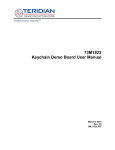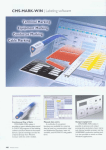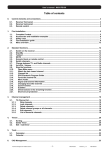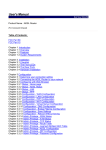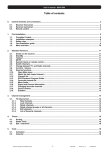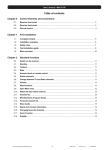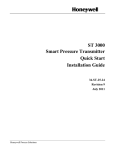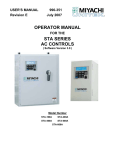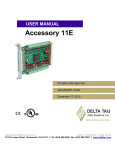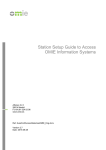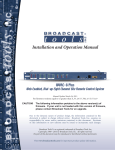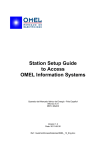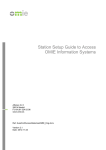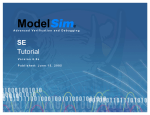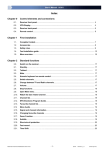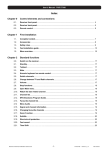Download AT IPC 620 - Artisan Technology Group
Transcript
This is the html version of the file http://honeywell.silverw.com/docs/620-8984.pdf. Google automatically generates html versions of documents as we crawl the web. Page 1 Honeywell IPC 620 Programmable Controller Model IPC 620-25 and 620-35 User Manual Form 620-8984 Rev.B Effective: 2/88 Supersedes: 1/87 Page 2 Copyright, Notices, and Trademarks Printed in U.S.A. - © Copyright 1988 by Honeywell Inc. Revision B- June, 1988 While this information is presented in good faith and believed to be accurate, Honeywell disclaims the implied warranties of merchantability and fitness for a particular purpose and makes no express warranties except as may be stated in its written agreement with and for its customer. In no event is Honeywell liable to anyone for any indirect, special, or consequential damages. The information and specifications in this document are subject to change without notice. Product Trademarks 620 LCS® and Honeywell 620 Logic Controller System® are registered trademarks of Honeywell, Inc. Beiden® is a registered trademark of Cooper Industries. IBM AT® is a registered trademark of IBM Corp. MS-DOS® is a registered trademark of Microsoft Corp. Slo-Blo® is a registered trademark of Littelfuse, Inc. Honeywell Industrial Automation and Control Automation College 100 Virginia Drive Fort Washington, PA 19034 (215) 641-3126 Page 3 TABLE OF CONTENTS INTRODUCTION PAGE 5 HARDWARE DESCRIPTION 6 System Specifications 6 620-25 and 620-35 Processor Components 7 Processor Rack 9 Memory Module (MM) .10 Register Module (RM) 10 System Control Module (SCM) 12 Processor Module (PM) 12 I/O Control Module (IOCM) 12 Power Supply Modules (PSM) 12 Parallel Link Driver Module (PLDM) 13 Serial Link Module (SLM) 13 Communications Interface Modules (CIM) 13 Control Network Module (CNM) 13 Hiway Interface Module (HIM) 14 Redundancy Control Module (RCM) 14 621 I/O System 14 621 I/O Full Rack 14 621 I/O Half Rack 14 I/O Rack Power Supply Modules (PSM) 14 Parallel Input/Output Module (PIOM) 15 Serial Input/Output Module (SIOM) 16 Input/Output Modules 16 623-51 Loader/Terminal 16 IPC 623-60 MS-DOS Loader 16 627-70 COP Microcomputer 19 620-25 AND 620-35 SYSTEM CONFIGURATIONS 21 Local Parallel I/O 21 Addressing 21 Setting PIOM 621-9937 Switches 21 Remote Serial I/O 24 Serial I/O Specifications 24 Serial Addressing 24 Control Network Configuration 26 620-25 AND 620-35 THEORY OF OPERATION 27 Processor Modes of Operation 27 PROGRAM Mode 27 Software PROGRAM Mode 27 RUN Mode 27 Scan-Loss Timer , 28 Program Execution Sequence 28 RUN Mode Status 30 RUN/PROGRAM Mode 30 Augmented Run Mode Programming 31 ARMP Programming Changes 31 Programming Rules 32 Compatibility Concerns 32 DISABLE Mode 32 1 Page 4 PAGE Parallel I/O Theory of Operation 33 Parallel Operational Sequence 33 Parallel Shutdown 34 Serial I/O Theory of Operation 34 Power-up 34 System Operation 34 Serial I/O Status Information 35 SIOM Off-Line Hag 35 Input/PULL Data Ready 35 All SIOM's Active on Redundant Link 36 Starting Address of SIOM Off-Line 36 Number of SIOM's On-Line 36 System Restart/Reset.... 36 System Fault Detection 36 Programming Considerations 37 DIAGNOSTICS 38 System Power-Up Self-Test 38 Program Memory Check 38 On-Line Checks 39 I/O System Test 39 Monitoring Diagnostics 39 APPENDIX A 41 DIP Switch Settings 41 Front Panel LED's 45 System Status Table 46 Opcodes 46 Instruction Set 50 APPENDIX B 52 Superseded Components 52 Module System Compatibility 52 Memory Modules 52 Parallel Link Driver Module 53 Communications Interface Module 53 I/O Rack Power Supply Module 53 Parallel Input/Output Module 53 On-Line Editing and Programming Without ARMP 55 Superseded Serial I/O System 56 Page 5 LIST OF FIGURES FIGURE PAGE 1 620-25 and 620-35 System 5 2 620-25 Rack Configuration 8 3 620-35 Rack Configuration 8 4 Register Memory Map 11 5 Relationship Between ±15VDC and ±5VDC Source Current Loads (Model 621-9933) 15 6 Typical Digital I/O Modules 19 7 Double Swing Terminal Blocks 19 8 8- and 16-point Terminal Block Jumpers 20 9 32-point I/O Connectors 20 10 PIOM (621-9937) Switch Locations 22 11 PIOM (621-9937) SW3 - SW5 Switch Values 22 12 Example Parallel I/O Configuration 23 13 Example of Parallel and Serial I/O Addressing Configuration 25 14 Example of Control Network Configuration 26 15 620-25/35 Program Execution 29 16 Ladder Logic for Input/PULL Data Ready Bit 37 17 Example of Parallel and Superseded Serial I/O Addressing Configuration 58 LIST OF TABLES TABLE PAGE 1 Basic 620-25 and 620-35 Components 7 2 Option Modules in Processors 9 3 Rack Slots Assigned to Processor Modules 9 4 Input/Output Modules 17,18 5 Serial I/O Status Information 35 6 Functions of Checksum Registers 40 7 PLDM (620-0086) Switch Settings 41 8 PIOM (621-9937) Switch Settings 42 9 SLM (621-9939) Switch Settings 43 10 SIOM (621-9938,621-9940) Switch Settings 44 11 Operating States Shown by SLM LED's 45 12 Operating States Shown by SIOM LED's 45 13 Opcodes for 620-25/35 Instructions 47-49 14 Memory Module (620-0020, -0021, 0022) Configurations 52 15 PIOM (621-9930) Switch Settings 54 16 SLM (621-9936) Switch Settings 62 17 SIOM (621-9935) Switch Settings 63 18 620-20,620-30,620-25, and 620-35 Module/Rack Compatibility 64 Page 6 USER MANUAL CROSS REFERENCE FOR IPC 620-25/35 PROCESSORS MANUAL: MATERIAL COVERED: IPC 620-25 and 620-35 Processor User Manual Form No. 620-8984 Detailed hardware description; 62025 and 620-35 system configurations (processor and I/O); modes of operation; processor diagnostics; instruction set and opcodes. IPC 620 Installation User Manual Form No. 620-8996 620 system overview; system configuration for all processor models, parallel and serial I/O; addressing; rack assembly mounting; module settings (jumpers and DIP switches); module installation; cable and conduit routing; wiring; reference information on superseded model numbers. IPC 621 I/O Specifications User Manual Form No. 620-8995 I/O system overview; detailed module descriptions (digital input, digital output, special function); serial I/O system; fuse and battery requirements. IPC 623-51 Loader/Terminal User Manual Form No. 623-8999 Hardware description; installation; modes of operation; programming instructions and examples; editing and display functions; documentation and tape functions; troubleshooting and maintenance; codes and error messages. IPC 623-60 MS-DOS Loader User Manual Form No. 623-8993 Product description and requirements; installation and configuration; system startup and menus; IPC 620 instruction set; edit and display functions; program editing instructions; documentation; utility functions. IPC 620 Control Network Introduction/User Manual Form No. 620-8994 Control Network overview; hardware description; modes of operation; CNM communications; diagnostics; configuration; DIP switch settings; addressing; installation. IPC 620 Redundant Control System User Manual Form No. 620-8983 Redundant Control System overview; detailed hardware description; installation; configuration; applications considerations; modes of operation; theory of operation; DIP switch settings. IPC Data Collection Modules User Manual Form No. 620-8980 Overview of 620-0048 and 620-0052 modules; detailed hardware descriptions; theory of operation; instruction set, opcodes and descriptions; installation; wiring; Asynchronous Byte Count Protocol; DIP switch settings. IPC Communications Interface Module Form No. 620-8986 Overview of the 620-0043 CIM; hardware description; configuration; installation; wiring; instruction set; DIP switch settings. IPC Hiway Interface Module User Manual Form No. 620-8981 Overview of the 620-0081 HIM; hardware description; functional description; configuration; operation; diagnostics; DIP switch settings. Network Guide, Form No. 74-WS-2901 Gateway User Manual, Form No. 8250-10-16 Information on the 620-0044 CIM. Page 7 INTRODUCTION The IPC 620 Programmable Controller System fulfills three important factory automation requirements: * Control * Communications * Monitoring The 620 System consists of a choice of five control processors, a Universal I/O system, two programming devices, an industrial microcomputer plus, related software products, motion control products, monitoring products, and communication systems. This manual covers the use of the 62025 and 620-35 processors. Other 620 system products— the 623-51 Loader/Terminal, 627-70 Microcomputer, motion control products, 620 Control Network, 626 Support Controller, software products, and the other 620 processors are supported by their own literature. The User Manual Cross Reference Table summarizes the material covered in other 620 user manuals referenced in this manual. FIGURE 1 - 620-25 AND 620-35 SYSTEM Page 8 HARDWARE DESCRIPTION SYSTEM SPECIFICATIONS AC VOLTAGE* 115/230±15%** FREQUENCY * 47 to 63 Hz DC VOLTAGE* 20to28VDC NORMAL LOAD* 115 Watts SURGE CURRENT* 15Alcyclefrom cold start POWER FAIL LEVEL* 115VAC-85VAC 230VAC - 190VAC 24VDC - 19VDC POWER FAIL DELAY* 11.5ms (115VAC) 7.0ms (24VDC) OPERATING TEMPERATURE* 0to60°C STORAGE TEMPERATURE* -40to85°C (-40 ° to 70° C with battery) RELATIVE HUMIDITY * 5% to 95% (non-condensing) HEIGHT* 10.7in (27.2cm) WIDTH* 19in (48.3cm) [I/O Half rack lOin (25.4cm)] DEPTH* 75in(19.1cm) I/OCAPACITY 2048 max. CONTROL RELAY CAPACITY 2048 or 4096 DATA REGISTERS 2048-4096 REGISTER SIZE 17-Bit (16-bit plus sign bit) MEMORYSIZES 2K,4K,8K,16K, 24K, 32K words MEMORY TYPE Read/Write CMOS BATTERY BACKUP 1.5 years minimum BATTERY Size D Lithium (629-3001) (located in Power Supply Module) MEMORY USAGE One word per ladder diagram element SCAN RATE 2.5ms per K (Relay only)*** 6.05ms per K (Nominal Mix)*** 8.88ms per K (Math intensive)*** * Also applies to the 621 I/O system. *** 250VAC maximum (fuse rating). Based on analysis of actual user programs for machine control Page 9 620-25 AND 620-35 PROCESSOR COMPONENTS The 620-25 or 620-35 processor systems may be ordered as individual components or as a processor system package. Refer to the 620 System Configuration Guide and the Price List for detailed ordering information. Figures 2 and 3 show processor rack configurations. A basic processor is assembled from the components listed in Table 1. The 620-25/35 processors can also include various option modules. There are four slots in the 620-35 (two in the 620-25 processor rack) to accommodate optional modules. Option slots that are not used are enclosed with blank coverplates. Empty SLM slots are enclosed with coverplates which are ordered separately. Table 2 shows which option modules can be incorporated into the basic processors. TABLE 1 - BASIC 620-25 AND 620-35 COMPONENTS COMPONENT MODEL NO. 620-25 Processor Rack 620-2590 620-35 Processor Rack 620-3590 620-25/35 Processor Module 620-0080 620-25/35 System Control Module 620-0054 Memory Module (2K) 620-0025 Memory Module (4K) 620-0026 Memory Module (8K) 620-0027 Memory Module (16K) 620-0023 Memory Module (24K) 620-0024 Register Module (2K X 2K) 620-0055 Register Module (4K X 4K) 620-0056 512 I/O Control Module 620-0057 1024 I/O Control Module 620-0058 2048 I/O Control Module 620-0085 Power Supply Module (115/230VAC) 620-0036 Power Supply Module (24VDC) 620-0047 Parallel Link Driver Module 620-0086 Serial Link Module 621-9939 Page 10 A Blank slot for optional module H B Blank slot for optional module J C Memory Module K D Register Module L E System Control Module M F Processor Module N G I/O Control Module FIGURE 2 - 620-25 RACK Power Supply Module I/O* I/O* I/O or Serial Link Module * I/O or Serial Link Module * Parallel Link Driver Module CONFIGURATION A B C D E F G Blank slot for optional module Blank slot for optional module Blank slot for optional module Blank slot for optional module Memory Module Register Module System Control Module H Processor Module I I/O Control Module J Power Supply Module L Serial Link Module M Serial Link Module N Parallel Link Driver Module FIGURE 3 - 620-35 RACK CONFIGURATION * Refer to TABLE 4 - INPUT/OUTPUT MODULE for a selection of available I/O and to FIGURE 12 - PARALLEL I/O CONFIGURATION, and FIGURE 13 - REMOTE SERIAL I/O CONFIGURATION for more information. The 620-25 Processor Rack does not accommodate I/O modules that use PUSH/PULL interface or 32point I/O modules. Page 11 PROCESSOR RACK Model No. - 620-2590 (620-25) 620-3590 (620-35) The processor racks include the chassis, backplane, and frontplates. The processor modules are vertically positioned in the racks with component side toward the left. Backplane connectors are offset to prevent inserting a module upside down. Card slots (labeled A through N) and the modules which they accommodate are shown in Table 3. The rack fits into an 8-inch NEMA 12 enclosure, or a 19-inch instrumentation rack. The rack conforms to the European "HE" standard. Reversible mounting brackets allow the rack to be panel mounted. When the brackets are attached to the rack front, it mounts in a standard 19-inch rack. When the brackets are rotated 180° and mounted to the rear, the rack can be panel mounted. TABLE 2 - OPTION MODULES IN PROCESSORS MODULES SYSTEM QUANTITY 620-25 620-35 Control Network Module (620-0038) 1-2 1-4 Communications Interface Modules (620-0044,620-0043) 1-2 1-4 Data Collection Module (620-0048,6200052) 1 1 Hiway Interface Module (620-0081) 1 1 Redundancy Control Module (620-0059) 1 1 TABLE 3 - RACK SLOTS ASSIGNED TO PROCESSOR MODULES MODULE RACK SLOT ASSIGNMENT 620-25 620-35 Optional Modules (Blank coverplates provided with rack) Control Network Modules A&B A-D Communication Interface Modules A&B A-D Data Collection Module A&B A-D Highway Interface Module A&B A-D Redundancy Control Module A&B A-D Memory Module A-C A-E Register Module D F System Control Module E G Processor Module F H I/O Control Module G I Power Supply Module H&I I/O Modules * J,K,L&M — Serial Link Modules L&M L&M Parallel Link Driver Module N N * The 620-25 Processor Rack does not accommodate I/O modules which use the PUSH/PULL interface. Page 12 Page 13 0 2047 Input Status Table Output Status Table - System Status Table (8-bit) 4111 Reserved for .01 Second Timers Sign Bit Data Registers (16-bit) 6143 8191 Sign Bit Data Registers (16-bit) FIGURE 4 - REGISTER MEMORY MAP 11 Page 14 SYSTEM CONTROL MODULE (SCM) Model No. - 620-0054 The System Control Module, a functional extension of the Processor Module, coordinates the interaction of all the modules in the processor. The SCM also contains a single-bit processor that solves all relay logic in the control program. The SCM is installed in rack slot E in the 62025 and slot G in the 620-35. A status indicator is located on the front panel of the SCM. The green LED labeled PASS energizes after successful completion of the self-test. PROCESSOR MODULE (PM) Model No. - 620-0080 The Processor Module executes the program stored in the memory module and handles arithmetic computation and data movement instructions. The Processor Module is installed in slot F in the 620-25 and slot H in the 620-35. Two status indicators are located on the front of the PM. The green LED labeled PASS energizes when the module passes its self-test. The red LED labeled TESTING energizes when the series of diagnostic tests are initiated on system power-up. The TESTING LED appears to remain energized as long as the processor is scanning since a short series of diagnostics, which occurs at the beginning of each scan, continually activates it. The port labeled Loader/Terminal connects to the 623-51 Loader/Terminal and is protected by a removable coverplate. I/O CONTROL MODULE (IOCM) Model No. - 620-0057 (512 I/O) 620-0058 (1024 I/O) 620-0085 (2048 I/O) The Input/Output Control Module coordinates communications between the processor and the 621 I/O system and formats the data flowing between the I/O system and the processor. It also monitors individual I/O module fault diagnostics. The IOCM works in conjunction with the Parallel Link Driver Module and/or Serial Link Module to control data flow to I/O. The IOCM is installed in slot G in the 620-25 and slot I of the 620-35. POWER SUPPLY MODULES (PSM) Model No. - 620-0036 (115/230VAC) 620-0047 (24VDC) The Power Supply Module provides power to operate the processor. The PSM is installed in slot H in the 620-25 and J in the 620-35. The module occupies the space of two processor rack slots - H and I in the 620-25 and J and K in the 620-35. A battery compartment in the PSM contains a lithium battery which provides backup power to the memory and register modules. The PSM is shipped with the battery installed. NOTE An insulating wafer prevents battery discharge during shipment and storage and must be removed before the system is operated. A figure showing how to remove the wafer is shown under Module Installation in the 620 Installation Manual (FormNo. 6208996). The PSM provides a maximum of 15 Amps of +5DC power for use by the processor rack modules. It also supplies 300mA of +12VDC for optional modules requiring those voltages. Two status indicators are located on the front of the PSM. A green LED labeled POWER indicates that power is being applied to the module. A green LED labeled BATTERY PASS remains energized as long as the battery is in good condition and power is applied. Model No.- 620-0036 (115/230VAC) Terminals on the front panel are labeled A (Line or LI), B (Common or L2), and GND for connecting AC power wiring. The 6200036 operates on user-selected voltage of 115VAC or 230VAC. The yellow shorting board located inside the side cover at the top rear edge sets the AC voltage. The 620-0036 contains a frontaccessible fuse holder. The module is shipped with a 2 Amp SLOBLO fuse installed for 115VAC operation. A 1 Amp SLO-BLO fuse for 230VAC is also shipped with the PSM. 12 Page 15 Model No. - 620-0047 (24VDC) Terminals on the front panel are labeled +, -, and GND. The 620-0047 operates on 20-25VDC voltage. The 620-0047 contains a front accessible fuse holder. The module is shipped with an 8 Amp SLOBLO fuse. PARALLEL LINK DRIVER MODULE (PLDM) Model No. -- 620-0086 The Parallel Link Driver Module works with the IOCM module to control I/O communications. The PLDM also controls system status by the mode keyswitch, and it determines I/O response to system faults and various operating parameters. The PLDM is installed in slot N in both the 620-25 and 620-35 processors. The front panel of the PLDM contains three LED status indicators, a processor mode keyswitch, and a D connector that interfaces the processor with the I/O system. The green LED labeled RUN energizes while the processor is scanning the ladder diagram program and is operating correctly. The red LED labeled FORCE energizes when at least one address in the program is in the forced state. The green LED labeled PASS energizes when the PLDM has passed its selftest. The processor keyswitch has four positions for selecting processor mode of operation. The positions are labeled PROGRAM, DISABLE, RUN/ PROG, and RUN. Two DIP switch banks are located on the top edge of the PLDM. The banks are labeled SW1 (four switches) and SW 2 (eight switches). The switches select the I/O response to system faults and various operating parameters. This module replaces the 620-0033. The two modules are the same physically and functionally. SERIAL LINK MODULE (SLM) Model No. - 621-9939 The SLM froñtplate has five LEDs indicating the status of the module. The operating states of the SLM are shown by the status of the front panel LED's. These states are shown in Table 11 in Appendix A. The green active light indicates that data is being transmitted properly. The normal state of the light is ON during transmission. There is one of these LED's for each channel. There is a yellow link fault LED for each channel. It indicates that a rack fault or a communication fault has occurred on the channel. The normal state is OFF. When a link fault occurs, this LED turns ON. It remains ON as long as the problem exists, unless power is cycled at the SLM or the serial system in which the fault exists is reset by shorting the reset terminals at the SLM. After the SLM has been reset or had power cycled, the serial system re-initializes. This includes the drops taken off-line, except those that have been manually powered down because of the fault, and the link fault LED is turned OFF. The LED remains ON if the faulted racks are restarted by a means other than resetting or cycling power at the SLM. A DIP switch, SW1, located near the top edge of the circuit board configures the SLM. The switch settings are shown in Table 9 in Appendix A. This module must be used with SIOM 6219938 or 621-9940. Also, this module replaces the 6219936 which is described in Appendix B and must be used with SIOM 621-9935. COMMUNICATIONS INTERFACE MODULES (CIM) Model No. - 620-0044 620-0043 620-0048 620-0052 The Communications Interface Modules are optional in the 620-25/35 processor. They provide interface to the 627-70 COP microcomputer or other serial devices. See the respective documentations for further information. The contents of the user manuals for these products are listed in the User Manual Cross Reference Table. CONTROL NETWORK MODULE (CNM) Model No. - 620-0038 The 620 Control Network is an easy-touse, high speed peer-to-peer communication network, providing peer-to-peer communication between a maximum of eight 620 processors. Installing a CNM in the 620-25/35 enables the processor to communicate with as many as seven other 620 processors, 13 Page 16 transferring I/O status bits or register data between processor systems which are interconnected on a multi-drop twisted-pair serial link. Two CNM's may be installed in the 620-25 and four CNM's in the 62035 enabling the processors to communicate with as many as two or four separate Control Networks respectively. The CNM may be installed in any of the option slots A or B in the 620-25 and A through D in the 620-35. See CNM documentation for further information. The contents of the CNM User Manual are listed in the User Manual Cross Reference Table. 621 I/O FULL RACK Model No. - 621-9990 The 621 I/O full rack is identical in size to the 19-inch 620 processor racks. It is designed for installation in 8-inch NEMA 12 enclosures or 19-inch instrumentation racks. It holds a maximum of 12 I/O modules, either a Parallel or Serial I/O Module, and a Power Supply Module. Model No. - 621-9992 HIWAY INTERFACE MODULE (HIM) Model No. - 620-0081 The HIM acts as an interface between an IPC 620 Processor and Honeywell's TDC3000 Data Hiway. The HIM provides a service facility for higher order devices in the system, such as computers and operator stations to interface with the IPC 620 Processor. The HIM is a single-slot option module that can be installed in any IPC 620 Processor rack. It provides redundant BNC connectors that attach directly to the Data Hiway. The module has the same functional capacity as up to four Data Hiway Port (DHP) modules. It also implements the same point structure as the DHP from the Data Hiway. See the HIM User Manual for further information. The 621-9992 augmented I/O rack is identical to the 621-9990 I/O rack in size and function. It contains an additional upper bus on the backplane to facilitate communication between modules within the I/O rack . This rack is used with modules which require dual bus communication (ie. Servo Modules). 621 I/O HALF RACK Model No. - 621-9991 The half rack is approximately one half the width of a full rack. It accommodates a maximum of six I/O modules, a Parallel or Serial I/O Module and a Power Supply Module. The half rack is useful for installation in narrow enclosures such as motor control centers. REDUNDANCY CONTROL MODULE (RCM) Model No. - 620-0059 The Redundancy Control Module is the primary component in the Honeywell IPC 620 Processor Redundancy System. The high-availability control system requires minimal hardware and installation effort. It operates with the IPC 620-25 or 620-35 Processors. The system consists of two identically configured processors, each containing an RCM. Both processors are connected to a common I/O system. The RCM's are connected to each other by a data cable. Redundant systems can be configured using parallel, serial or both types of I/O. See Redundant Control System User Manual for more information. 621 I/O SYSTEM I/O RACK POWER SUPPLY MODULES (PSM) Model No. - 621-9932 (8A, 24VDC) The 621-9932 I/O Rack Power Supply provides 8 amps of +5VDC for the I/O logic circuitry in the rack. It also supplies 600mA of +15VDC power. Refer to the 620 Installation Manual for individual module power requirements. The maximum power consumption of the 621-9932 Power Supply is 96VA. A cold start surge of this power supply requires a maximum of 40 amps. The required input is 20-28VDC with a 24VDC nominal input. The Power Supply Module offers a front-accessible fuse holder and is shipped with an 8A Fast-blo fuse. A green LED labeled 5V PASS is energized when the 5VDC power is present. The I/O system consists of I/O full or half racks, Power Supply Modules, Parallel or Serial I/O Modules, and various digital, analog and special function I/O modules. 14 Page 17 Model No. - 621-9933 (15A, 115/230VAC) Model No. - 621-9934 (8A, 115/230VAC) The 621-9933 I/O Rack Power Supply is a double-wide module that provides 10 to 15 amps of +5VDC for the I/O logic circuitry in the rack. It also supplies 1.3 to 2 amps of ±15VDC The graph in Figure 5 shows the relationship of current loads between the ±15VDC source and the ±5VDC source. If, for example, the +15VDC source requires 2 amps, the 5VDC can draw a maximum of 10 amps. If the +15VDC requires 1.3 amps, the ±5VDC can draw a maximum of 15 amps. Refer to the 620 Installation Manual or individual module specifications for module power requirements. The maximum power consumption of the 621-9933 Power Supply is UOVA. A cold start surge requires a maximum of 20 amps for one cycle. The input is selectable for 115 or 230VAC by the position of a toggle switch located under the component cover of the Power Supply. The 115VAC selection allows a voltage range of 85 to 132VAC. The 230VAC allows a 170 to 250VAC operation. The frequency for both ranges is 47 to 63 Hz. The Power Supply Module offers a frontaccessible fuse holder. It is shipped with a 4.0A SLO-BLO fuse installed for 115VAC operation. The 230VAC 2.0A SLO-BLO fuse is also shipped with the module. One green LED, labeled 5VDC, is energized when the 5VDC power is present. NOTE Be sure to match the 115/230VAC toggle switch with the module fuse. The 621-9934 I/O Power Supply provides 8 amps of +5VDC power. This module also provides 600mA of ± 15VDC power for the operation of some special function I/O and analog I/O modules. The power supply is selectable for 115/230VAC operation, 47- 63Hz. A terminal block at the top of the module front coverplate is labeled with an A (Line or LI), a B (Common or L2), and a ground symbol for AC input wiring termination. A front-accessible fuse holder houses a 2 amp SLO-BLO fuse for 115VAC operation. A 1 amp SLO-BLO fuse for 230VAC operation is also shipped. PARALLEL INPUT/OUTPUT MODULE (PIOM) Model No. - 621-9937 The PIOM is located in the N slot in the full 1/ O rack or the H slot in the I/O half rack. This module acts as the interface to the processor Parallel Link Driver Module and to other PIOMs. The PIOM has two 50-pin D-type connectors. The male plug (top) is the ESI port and the female plug (bottom) is the OUT port. The green LED, labeled ACTIVE, indicates proper communication from a preceding rack. Amps Supplied from±15VDC Source 2.2 2.0 1.8 1.6 1.4 1.2 1.0 0.8 0.6 0.4 0.2 0.0 0 8 10 12 14 16 Amps Supplied from 5VDC Source FIGURE 5 - RELATIONSHIP BETWEEN ±15VDC AND ±5VDC SOURCE CURRENT LOADS (MODEL 621-9933) 15 Page 18 Two DIP switch banks, SW1 and SW2, select rack configuration and output handling. Three DIP switch banks, SW3, SW4, SW5 set the number of I/O points used in each I/O rack slot. The 621-9937 replaces the 621-9930. See Appendix B for information on the 621- 9930. SERIAL INPUT/OUTPUT MODULE (SIOM) Model No. - 621-9938,621-9940 The 621-9938 has two serial ports and the 6209940 has one. The 621-9938 is used in redundant applications which require communication with redundant processors. The 621-9938 frontplate has six LED's for indicating the module status and the 6219940 has three. The green active LED indicates that the associated port is transmitting and receiving data properly. The light is ON when transmitting. The green pass LED indicates the SIOM has successfully completed its self-test which occurs on power-up and when the SIOM reset terminals are closed. The normal state is ON. Double swing terminal blocks that attach to the rack chassis fit over 8- and 16point modules, splitting the field wiring into two small bundles. One terminal block swings down, closing from the top of the rack, the other swings up, closing from the bottom, both fitting over the installed I/O module. The terminal blocks lock open for easy installation or removal of the module without disconnecting the field wiring. The 8-point terminal block models are factory jumpered at Tl and T2 and Bl and B2. The 16-point terminal block models are factory jumpered at TI, T2, and T3 and Bl, B2, and B3. These terminals are field power and return connections and the jumpers select the number of points per common. See Figure 8. The 32-point I/O modules use two removable connectors that attach to the front of the module. The field wiring is installed in the front of the module using set screws that can be accessed without removing the connector from the module. If a connector must be removed, metal connector bars eject the connectors from the module. See Figure 9. The yellow rack fault LED indicates that an output module data fault has occurred. The LED is normally OFF. The green lead LED indicates that the port is connected to the lead processor in a redundant configuration and is successfully communicating with the lead processor's SLM. The normal state is ON for the port connected to the lead processor and OFF for the port connected to the backup processor. Only one LED is ON at a time. The statuses of the front panel LED's show the operating state of the SIOM. These statuses are shown in Table 12 in Appendix A. Five banks of DIP switches, located near the top edge of the circuit board, set how the rack is configured and how outputs are handled, and the number of I/O points used in each I/O rack slot. The functions of these switches are shown in Table 10 in Appendix A. INPUT/OUTPUT MODULES The 621 Universal I/O System offers a variety of 8-, 16- and 32- point digital modules, analog, and special function module types. Figure 6 shows typical I/O modules and Table 4 provides a complete list of 621 I/O modules. 623-51 LOADER/TERMINAL The 623-51 Loader/Terminal is a programming, monitoring and documentation tool used with the 620-25/35 processors as well as the other 620 processors, the 627-70 COP Industrial Microcomputer, and other ASCII peripheral devices. The 623-51 Loader/Terminal may also be used as a stand alone 620 program development system. Refer to the Loader/Terminal User Manual 6238999 for detailed programming and operating information. IPC 623-60 MS-DOS LOADER The 623-60 MS-DOS Loader is a software/ hardware package that gives any MSDOS operating system personal computer the capability to program and monitor all IPC 620 programmable controllers. The MS-DOS Loader consists of two 5 1/4-inch floppy disks, one 31/2 floppy disk and a board to interface to the IPC 620 PLC or a PC/PLC adapter. The easy-to-use software is menudriven and includes a comprehensive series of help screens. The Loader integrates programming and documentation. Editing is simple because the link between ladder logic and documentation is maintained during editing. 16 Page 19 TABLE 4 - INPUT/OUTPUT MODULES COMPONENT GROUP MODEL NUMBER DESCRIPTION INPUT MODULES 621-0000 Analog Input, 8 channels* 621-0009 Simulator Input Module 621-0014 Therrnocouple/mV Input Module* 621-1100 115V AC/DC, 8-pt. 621-1101 115VAC/DC Isolated, 6-pt. 621-1151 115VAC, 16-pt. 621-1175 115VAC, 32-pt. 621-1200 230VAC/DC, 8-pt. 621-1201 230VAC/DC Isolated, 6-pt. 621-1500 24VAC/DC, 8-pt. 621-1550 24VAC/DC, 16-pt. 621-3300 5VDC Sink, 8-pt. 621-3450 12VDC Sink, 16-pt. 621-3500 12-24VDC Sink, 8-pt. 621-3502 12-24VDC Sink Fast Response, 8-pt. 621-3550 24VDC Sink, 16-pt. 621-3552 24VDC Sink Fast Response, 16-pt. 621-3575 24VDC Sink, 32-pt. 621-3600 48VDC Sink, 8-pt. 621-3650 48VDC Sink, 16-pt. 621-4300 5VDC Source, 8-pt. 621-4350 5V TTL, 16-pt.** 621^4500 12-24VDC Source, 8-pt. 621-4502 12-24VDC Source Fast Response, 8pt. 621-4550 24VDC Source, 16-pt. * Uses PUSH/PULL interface exclusively and does not function in the 620-25 Processor Rack. ** Uses PUSH/PULL interface, but not exclusively. PUSH/PULL interface does not function in the 620-25 Processor Rack. 17 Page 20 TABLE 4 - ] [NPUT/OUTPUT MODULES (CONT.) COMPONENT GROUP MODEL NUMBER DESCRIPTION OUTPUT MODULES 621-0007 Reed Relay, 6-pt. 621-0010 Analog Output, 4 channels * 621-2100 115VAC, 8-pt. 621-2101 115VAC Isolated, 6-pt. 621-2102 115VAC Source Self-Protected, 8-pt. 621-2150 115VAC, 16-pt. 621-2175 115VAC, 32-pt. 621-2200 230VAC, 8-pt. 621-2201 230VAC Isolated, 6-pt. 621-2500 24VAC 8-pt. 621-2550 24VAC, 16-pt. 621-6300 5VDC Source, 8-pt. 621-6350 5V TTL, 16-pt. ** 621-6450 12VDC Source, 16-pt. 621-6500 12-24VDC Source, 8-pt. 621-6501 12-24VDC Source Self-Protected, 8-pt. 621-6550 24VDC Source, 16-pt. 621-6551 24VDC Low Power Source, 16-pt. 621-6575 24VDC Source, 32-pt. 621-6600 24VDC Source, 8-pt. 621-6650 48VDC Source, 16-pt. 621-6700 120VDC Source (0.5 A), 8-pt 621-6701 120VDC Source (2A), 8-pt. 621-0004 System Diagnostic Module** 621-0006 BCD Converter* SPECIAL 621-0008 Pulse Input Module** FUNCTION 621-0012 ASCII Communications Module** MODULES 621-0016 Controller Access Module** 621-0018 Absolute Encoder Module** 621-0306 High Speed Counter** Uses PUSH/PULL interface exclusively and does not function in the 620-25 Processor Rack. ** Uses PUSH/PULL interface, but not exclusively. PUSH/PULL interface does not function in the 620-25 Processor Rack. 18 Page 21 627-70 COP MICROCOMPUTER The 627-70 is a stand-alone industrial microcomputer. When interfaced with a programmable controller, the unit is capable of reading and writing inputs, outputs, registers and program memory. The flexibility of the BASIC09 programming language allows the COP to use programmable controller data to provide an efficient machine-tohuman interface by communication with color graphic displays, printers, touch panels, card readers, etc. The COP is available in several configurations. One configuration offers 32K for BASIC09 programming. Other configurations use RAM memory to emulate a disk drive. This COPRAM disk system offers up to 144K of RAM. The large memory enables the COP to perform sophisticated data handling functions. It includes two RS232/422 compatible ports that can be expanded to a total of eight ports, providing extensive high speed data transfer between programmable controllers (ICD and other manufacturers) and ASCII devices. Specific information pertaining to the 627-70 COP Industrial Microcomputer is contained in the 62770 User Manual. 304 306 306 307 T1 T2 e e 61 62 306 309 310 311 • 8888 FIGURE 6 - TYPICAL DIGITAL I/O MODULES FIGURE 7 - DOUBLE SWING TERMINAL BLOCKS 19 Page 22 8-PT. JUMPER 16-PT. JUMPER FIGURE 8-8- AND 16-POINT TERMINAL BLOCK JUMPERS CONNECTOR BAR CONNECTOR BAR — FIGURE 9 - 32-POINT I/O CONNECTORS 20 Page 23 620-25 AND 620-35 SYSTEM CONFIGURATIONS LOCAL PARALLEL I/O The Parallel I/O Configurations are designed for those applications in which long distances between 621 I/O racks and the processor are not required. A maximum data cable length of 100 feet is allotted for parallel I/O within a 62025/35 system. The Parallel Link Driver Module, housed within the 620 processor rack provides a 50-pin D connector. This connector is cabled to one of the two ports on a Parallel I/O Module (PIOM) within the 621 I/O rack. Additional racks may be connected via the PIOM port in a daisy-chain fashion. The 620-25/35 offers a maximum of 2048 I/O points. ADDRESSING The starting address must be set for each I/O rack in a parallel I/O system, and each I/O slot must be set for 0,8,16, or 32 addresses. Normally, the starting address of the first I/O rack is zero. Addi- tional I/O rack starting addresses are set at 1 plus the ending address of the previous I/O rack. Each I/O slot is normally set for the type of 1/ O module to be installed in the slot (i.e. 8 addresses assigned to a slot that will contain an 8point I/O module). Slots can be set for more addresses than the installed module (i.e. 32 addresses assigned to a slot that will contain a 16-point module). Zero can be assigned to a slot when necessary for double width modules. address. When I/O modules are installed in the 62025 processor rack, their addressing begins with 0 and ends with 31 or 63 depending on whether 8 or 16 points per slot are selected on the PLDM. 32-point 1/ O modules cannot be used within the four I/O slots of the 620-25 Processor rack. SW2 switches 1 and 2 determine rack output states if an output fault occurs. SW3, SW4, and SW5 switches set the number of I/O addresses assigned to each rack slot. Each pair of switches, beginning with SW5 switches 1 and 2, set each slot A - L for 0,8,16 or 32 I/O points. Slots may be set for 0 points when they are occupied by multislot special function modules which may not require I/O addresses. Figure 11 shows PIOM SW3, SW4, SW5 switch selections. Figure 12 shows an example parallel I/O configuration. SETTING PIOM 621-9937 SWITCHES PIOM switch locations are shown in Figure 10. SW1 switches 1 - 8 set the rack starting address. These switch values are assigned in increments of 8. Closing a switch adds that value to the starting 21 Page 24 SW2 SW3 1 SW4 1 1 1 SWl SW5 V1 FIGURE 10 - PIOM DIP SWITCH LOCATIONS (621-9937) Example: Slot A, 16-pt. Module SW5 ION 2 OFF Slot B, 8-pt. Module SW5 3 OFF 4 ON Slot K, 32-pt. Module SW3 5 OFF 6 OFF IPC 621 I/O RACK A B C D E F G H I J K L PIOM SW5 PIOM SW4 PIOM SW3 I/O POINTS SWITCH PAIR LOWER HIGHER 0 CLOSED/ON CLOSED/ON 8 OPEN/OFF CLOSED/ON 16 CLOSED/ON OPEN/OFF 32 OPEN/OFF OPEN/OFF Lower Switch 11 2 B cd 314 co B 51 6 B CD Higher Switch 718 B CD ill w Uh H H O O ij CD CD 3 14 516 B CD 1 |2 3 14 5| 6 i LOT J B H O C/3 CD CD CD 718 B CD FIGURE 11 - PIOM (621-9937) SW3 SW5 SWITCH FUNCTIONS 22 Page 25 RACK RACK STARTING ADDRESS RACK ENDING ADDRESS I/O POINTS PER SLOT A B C D E F G H I J K L 1 0 223 8 8 8 8 16 16 16 16 32 32 32 32 2 224 367 8 8 8 8 16 16 16 16 32 8 8 * Slots D and H are reserved for future use. Eight addresses are allowed for slot D and 16 addresses are allowed for slot H. Slots J and K of rack 2 are used for a double-wide special function module. Slot K is set for 0 since the module plugs into slot J. SW5 SW4 SW3 SLOT D H I J K SWITCH 345 8 1 234 533553 8 1 8 RACK 1 ili mm mm Ss s mm mm www? HffiWt HB tms mm. li fix: . Ni :ftw RACK 2 AT IPC 620 -35 PROCESSOR P L D M 0 IPC 620 I/O RACK P I O M 223 224 IPC 620 I/O RACK P I O M 367 I OPEN/OFF CLOSED/ON FIGURE 12 - EXAMPLE PARALLEL I/O CONFIGURATIONS 23 Page 26 REMOTE SERIAL I/O NOTE The serial I/O system described in this section supersedes the system covered in previous versions of this manual. This serial system uses Serial Link Module (SLM) 621-9939 and Serial I/O Module (SIOM) 621-9938 or 621-9940. The two systems are not compatible. Information pertaining to the superseded system, which is not obsoleted, is included in Appendix B. SERIAL I/O SPECIFICATIONS DATA TRANSFER MEDIUM Serial 4-wire full duplex (asynchronous to processor scan) DATA RATE 115.2K baud ELECTRIC AL FORMAT RS422 SERIAL CHANNEL SCAN RATE Depends on the number of racks per link, number of discrete points per link, number of racks containing PUSH/PULL cards and the number of PUSH/PULL cards updated per scan (all or 1 per scan). MAXIMUM DROPS PER CHANNEL -. 16 MAXIMUM I/O PER CHANNEL 2040 MAXIMUM CHANNEL LENGTH .4000ft. (Beiden 9729, using 200 ohm terminating resistor) 10,000ft. (Beiden 9182, using 300 ohm terminating resistor) ERROR CHECKING Cyclical redundancy check plus data receive time out. Serial I/O allows I/O racks to be mounted close to the machine or process being controlled rather than at the processor. This eliminates the high cost of installing long wire runs. The 620-25/35 processor rack provides two slots, L and M, for Serial Link Modules. Two channels are operated by one SLM. Serial I/O Modules (SIOM) which are installed in each I/O rack connect to the serial channel in a multi-drop arrangement. This allows an I/O rack to be disconnected while communication to the other remote I/O racks oñ the link is maintained. The SLM operates independently of the processor, and processor scan time is not affected by remote serial I/O channels. SERIAL ADDRESSING Any mix of -0, -8, -16 and -32 point I/O mod- ules may be used in a serial I/O rack. Setting an 8position DIP switch establishes the starting address for each rack. Also, a pair of switches identifies each I/O slot within a rack for 0,8,16 or 32 points. Table 10 in Appendix A shows the switches for selecting rack addresses and identifying the number of points for I/O slots. Rack addresses are set in multiples of 8 by setting the appropriate DIP switches to the CLOSED/ON position and adding their values. For example, in Figure 13, the starting address of the first serial I/O rack (rack # 2) is 192. Switches 4 and 5 (64 + 128 = 192) are set CLOSED/ ON to assign a starting address of 192. Since rack # 2 has 384 I/O points, the starting address of rack # 3 is 576 (192 + 384 = 576). Switches 4 and 7 (64 + 512 = 576) are CLOSED/ON to asssign a starting address of 576. Starting addresses may not overlap. Serial racks may not share the same starting address or have overlapping addresses. In the example, the serial racks are shown with consecutive adresses; however this is not necessary. Real I/O addresses may be skipped between racks or the first rack on the link may have a higher starting address than the second rack, provided addresses do not overlap. Because of this feature, serial racks may be laid out to accommodate future expansion or the physical layout of the plant. DIP switches SW3, SW4 and SW5 are set to designate the number of I/O points per slot. Each pair of switches from these banks designates the number of I/O points for an individual slot. Starting with slot A (leftmost slot) and assuming a 16-point 1/ O module, switches 7 and 8 of SW5 are CLOSED/ON to identify a 16-point module in slot A. This same procedure is used to set the remaining I/O slots for the corresponding point configuration. The maximum number of points per rack is 384 (32 pts. x 12 slots = 384). 24 Page 27 IPC 620-35 Processor Parallel I/O Rack#l 8,8-pt. Mods. 4,32-pt. Mods. Start. Addr. 0 Total Pts. 192 S L M P L D M P I O M Serial I/O Channel # 1 Rack #2 12,32-pt. Mods. Start. Addr. 192 Total Pts. 384 Rack #4 6,8-pt. Mods. 6, l¿-pt. Mods. Start. Addr. 832 Total Pts. 144 Rack #3 S I O 8,16-pt. Mods. 4,32 pt. Mods. Start. Addr. 576 Total Pts. 256 Serial I/O Channel # 2 S I O M Rack #5 7,8-pt. Mods. 5,32-pt. Mods. Start. Addr. 976 Total Pts. 216 S I O M S I O M Rack #6 6,16- pt. Mods. Start. Addr. 1192 Total Pts. 96 S I O M RACK I/O MODULES I/O PTS. PER RACK STARTING ADDRESS ENDING ADDRESS NO. PTS. 1 8 8 192 0 191 4 32 2 12 32 384 192 575 3 8 16 256 576 831 4 32 4 6 8 144 832 975 6 16 5 7 8 216 976 1191 5 32 6 6 16 96 1192 1287 FIGURE 13 - EXAMPLE OF PARALLEL AND SERIAL I/O ADDRESSING CONFIGURATION 25 Page 28 CONTROL NETWORK CONFIGURATION A Control Network is a high speed peertopeer communications system in which as many as eight programmable controllers can share I/O status over a serial channel. Installing the CNM in a 620-25/ 35 option slot enables the processor to communicate with as many as seven other 620 processors which are connected by a multi-drop, single twisted pair halfduplex link. Each CNM on the network can transmit either 32 or 64 discrete I/O points or two or four 16bit registers onto the network. All processors on the Control Network operate asynchronously. The network is fast enough to provide real time control. The trunk line can extend a maximum of 8000 feet. The transmission distance can be extended with the use of modems. Two types of Control Network configurations are possible. Typically, each processor on the network will contain only one CNM. It is optional though to install a maximum of four CNM's in the 620-25/35 processor enabling it to pass information from one network to another or to collect information from different networks. In such applications each CNM in the processor has a unique module number and a unique transfer table. Figure 14 illustrates a Control Network configuration. CONTROL NETWORK MODULES I 620 Programmable Controller I 620 Programmable Controller I 620 Programmable Controller I 620 Programmable Controller Up to eight controllers may be used. FIGURE 14 - EXAMPLE OF CONTROL NETWORK CONFIGURATION 26 Page 29 620-25 AND 620-35 THEORY OF OPERA TION PROCESSOR MODES OF OPERATION The four-position keyswitch on the front panel of the Parallel Link Driver Module determines the processor mode of operation. The 620-25/35 features four modes of operation: PROGRAM, RUN, RUN/PROGRAM, and DISABLE. PROGRAM MODE The system may be placed in the PROGRAM mode by the front panel keyswitch. The Processor Module does not execute the control program. The RUN LED on the Parallel Link Driver Module (PLDM) is OFF when the system is in the PROGRAM mode. When the processor is in the PROGRAM mode, a signal is transmitted to the I/O System which allows individual I/O racks to be selected to freeze or clear outputs. Contacts may be forced if the Force Enable Switch (SW2 switch 4) on the PLDM is CLOSED/ON. Timer/counter data stored in the Register Module may be changed regardless of the state of the Data Change Enable Switch (SW2 switch 5) since the processor is already in the PROGRAM mode. Switching the keyswitch to another processor mode removes the processor front the PROGRAM mode. If the system has been placed in the PROGRAM mode by the Loader/Terminal or a CIM, the software PROGRAM mode request must be removed from the processor causing the system to return to the mode of operation specified by the position of the keyswitch. SOFTWARE PROGRAM MODE The system can be placed in the Software PROGRAM Mode by the Loader/Terminal or a CIM. The programmable controller must be in the RUN/PROGRAM or DISABLE mode, and the on-line programming function enabled according to SW2 switch 6 on the PLDM. The system enters the Software PROGRAM mode only after the scan being executed is completed. When the Loader removes the Software PROGRAM Mode request, the processor leaves the software PROGRAM mode and returns to the original mode, after the system successfully executes the retentive scan and selfdiagnostics. Software PROGRAM mode changes are made through the LOADER/TERMINAL Mode change auxiliary menu. This function is particularly useful in the program debug stage for extensive changes. The user may monitor program execution, find a bug, change it, and execute the program from the keyboard. RUN MODE The system is in the RUN mode when the front panel keyswitch is in the RUN or RUN/PROGRAM position. The RUN mode is the main control mode for the processor. The system executes a retentive scan when it first enters the RUN mode. During the retentive scan all nonretentive outputs from 0 to 4095 are turned OFF. The retentive outputs retain the state they were in during the last scan executed prior to being removed from the RUN mode. After the retentive scan is complete, the user program scan begins by verifying that an Input Status Scan (ISS) instruction is located in the first memory location of the user program. While input status is being collected from the I/O system, the processor examines the card fault interrupt. If any card faults are detected in the I/O system, the fault information is inserted in the System Status Table. 27 Page 30 The processor then does a program memory scan by reading the second location in the Memory Module and continues through the user program until it encounters a Return to Beginning of Program or End of Memory instruction. Either of these instructions causes the scanning sequence to repeat, beginning with a new ISS. In this instance, a Return to Beginning of Program is an optional instruction programmed by the user. The End of Memory instruction is automatically deposited in the Memory Module by the device that loaded the program into memory. Scan-Loss Timer A scan-loss timer is reset on each scan. This timer performs a diagnostic function by timing each scan. If a scan runs beyond the scanloss timer's setting, the timer times out. When this happens, the processor stops scanning through the user program and clears or freezes outputs in the I/O system depending on the position of PIOM SW2 switch 1. A time out causes the RUN LED to turn off. If the scanloss timer has not reached its timeout setting before the end of the scan, the processor continues with the next scan, resetting the timer. Some valid ladder logic programming causes the scan timer to exceed the time-out setting. This type of programming requires the scanloss timer to be disabled. Closing SW1 switch 1 on the Parallel Link Driver disables the scan-loss timer. CAUTION Some of the processor's built-in diagnostic ability is disabled when the scan-loss timer is disabled. Program Execution Sequence Using the sample program in Figure 15, represented by the following logic lines, the program execution would be as follows: 101 32 67 -] [342 -] I32 -( )- The first instruction (-] [-101) is brought from memory causing a logical OR to be performed on the bits stored at address 101 of the Input and Output Status Tables of the Register Module. Assuming that input 101 was ON at input status scan, a binary 1 is stored in the Input Status Table at address 101. All output status table bit addresses are cleared to zeros during retentive scan, so the OR operation will result in a 1 (contact 101 CLOSED). The next instruction, (-] [- 67) is brought from memory and a logical OR performed on the Input and Output Status Tables at address 67. Assuming that input contact 67 is closed, a binary 1 is stored in the Input Status Table at address 67. The next instruction, (-] [ 32) is brought from memory. The processor recognizes that output 32 must be turned ON since both input contacts 101 and 67 are closed. The processor transmits a signal via the field I/O bus to energize output 32 and also posts a binary 1 in address 32 of the Output Status Table. The next instruction (-] [- 32) is brought from memory and a logical OR performed on the Input and Output Status Tables at address 32. Bit address 32 in the Input Status Table contains a 0, because no input module is in that position, but a binary 1 was just posted at address 32 in the Output Status Table as a result of the previous instruction. The result of the logical OR is a binary 1 (contact 32 closed). The next instruction (- ] [- 342) is brought from memory, and a logical OR performed on the Status Tables at address 342. Assuming that input contact 342 is OPEN, 0 is stored in the Input Status Table at address 342. The next instruction ( -( )- 384) is brought from memory. The processor recognizes that contact 32 is CLOSED, but contact 342 is OPEN, therefore, output 384 must be de-energized. The processor transmits the signal via the field I/O bus to de-energize output address 384 and posts a 0 in bit address 384 of the Output Status Table. 28 Page 31 Input Status Table Output Status Table Input Data To Input Status Table Updated Prior To Beginning Of Every Memory Scan. / f Each Output Updated At The Instant It Is Executed Into The Program OR Gate / Output Data To Output Status Table Push/Pull t Parallel I/O Cable Main Memory -] [101 -] [67 -( )- 32 -] [32 11 -] [* 342 11 -( )- 384 * 2K, 4K, 8K, 16K, OR 32K STATUS SCAN * SCANl t 0 t t = TIME STATUS SCAN * STATUS SCAN * JU SCAN 2 t * For IOCM Model 620-0057 - 771.00|is + l-2ms for diagnostics and option slot test. * For IOCM Model 620-0058 - 1.2ms + l-2ms for diagnostics and option slot test. * For IOCM Model 620-0085 2.06ms + l-2ms for diagnostics and option slot test. FIGURE 15 - 620-25/35 PROGRAM EXECUTION 29 Page 32 7. The remainder of the instructions are executed until the End of Memory instruction is reached. The EOM returns the program execution sequence to the first memory word of the program (the input status scan). Run Mode Status The RUN LED located on the Parallel Link Driver Module (PLDM) is energized when the system is in the RUN mode. The scan loss timer on the PLDM is enabled to time out after the time base has elapsed (determined by switches SW1 switch 2 through SW1 switch 4 on the PLDM). If the scan loss timer times out, the processor stops scanning through the user program and may or may not clear outputs in the I/O system, depending on the setting of PLDM SW2 switch 7. The internal run flag resets to run and the 0.01 second timer time base interrupt is enabled as long as the system is in the RUN mode. PLDM switches control the following machine status options: SW2 switch 4 Enable/Disable Force command SW2 switch 5 Enable/Disable data change The RUN mode offers the following options. Contacts may be forced if the force enable switch (SW2 switch 4) on the PLDM is CLOSED/ON. Timer/Counter preset and accumulated values, sequencer register values, and constant values may be changed if the data change enable switch (SW2 switch 5) on the PLDM is CLOSED/ON. Outputs in the I/O system may be cleared when the scan loss timer times out if the scan loss outputs switch (SW2 switch 7) on the PLDM is CLOSED/ON. The processor can be removed from the RUN mode by switching the keyswitch to another position or by entering a PROGRAM mode request command from the Loader/Terminal or a CIM. This is only applicable if the processor keyswitch is in the RUN/ PROGRAM or DISABLE position. When the processor receives a PROGRAM mode request, it enters the PROGRAM mode after the scan returns to the first location in the Memory Module. The processor stays in the PROGRAM mode until the requesting device removes it. Note, however, that the Loader/Terminal security code must be entered before the Loader/ Terminal actually performs a processor mode change. RUN/PROGRAM MODE When the programmable controller system is in the RUN/PROGRAM mode the system operates identically to the RUN mode with the added capabil- ity of making program changes. The user's program is executed as it is in the RUN mode. The RUN LED on the Parallel Link Driver Module (PLDM) is energized while the keyswitch is in the RUN/PROGRAM mode. RUN/PROGRAM mode enables the scan loss timer on the PLDM to time out after the time specified by the scan loss timer set point switches on the PLDM has elapsed. The scan loss timer does not time out if an input status scan is executed within the time specified by the scan loss timer set point switches. When a Loader /Terminal requests a program change to be made, the RUN light remains energized, and the scan loss timer remains enabled. The RUN/PROGRAM mode permits the following functions: element status may be forced by the Loader/Terminal if the force enabled switch (SW2, switch 4) on the PLDM is closed; and preset and accumulated values of timers and counters, sequencer register values, and constant values may be ¿hanged by the Loader/Terminal if the data change enable switch (SW2, switch 5) on the PLDM is closed. Augmented RUN Mode Programming is allowed if the on-line programming switch (SW2, switch 6) on the PLDM is closed. The PLDM switches control the following machine status options in the RUN/PROGRAM mode: SW2 switch 4 SW2 switch 5 SW2 switch 6 Enable/Disable Force function Enable/Disable data change function Enable/Disable on-line programming 30 Page 33 AUGMENTED RUN MODE PROGRAMMING (ARMP) The capability to make program changes while in the RUN/PROGRAM mode has been refined with the introduction of Augmented RUN Mode Programming (ARMP). This feature allows users to make control program additions and selections while in the RUN/PROGRAM mode with no adverse affect on system operation, other than temporarily increasing scan time (20 ms max.). ARMP is included with all 620-25 and 35 processors that have a firmware revision of 48 or greater. Earlier firmware versions can be upgraded to ARMP status by ordering upgrade kit 220-007 (compatible with Processor Module 6200080). To perform ARMP operations, the 62351 Loader /Terminal must also be compatible with the ARMP level of firmware. ARMP compatible loaders have a firmware revision level of E-98 or greater. Earlier versions of the L/T can be upgraded by means of one of the following upgrade kits: * 223-0007 * 223-0008 * 223-0009 * 223-0010 623-51 Upgrade Kit (English) 623-51 Upgrade Kit (German) 623-51 Upgrade Kit (French) 623-51 Upgrade Kit (Spanish) The 623-50 L/T is not ARMP compatible and must be updated to a 623-51 by installing one of the following upgrade kits: * 223-0001 * 223-0002 * 22300003 * 223-0004 623-50 Upgrade Kit (English) 623-50 Upgrade Kit (German) 623-50 Upgrade Kit (French) 623-50 Upgrade Kit (Spanish) ARMP Programming Changes Augmented RUN Mode Programming is possible only when the L/T is in the PROGRAM mode, the Processor keyswitch is in the RUN/ PROGRAM position, and the processor on-line programming DIP switch is enabled. Under these conditions, when the L/T is placed in the PROGRAM mode, this message is displayed: 620 IN RUN MODE: CAUTION: RUN MODE PGM ENABLED EDITING A LINE - An existing program line can be edited as usual. When the changes are complete, press LINE and ENTER. This message appears: CAUTIONr RUN MODE PROGRAM SELECTION ENABLED. DEPRESS LOAD TO EXECUTE/ ANY KEY TO CANCEL An additional message is displayed during a delete or line enter function: WARNING: LOADER IS NOT MONITORING LINE STATUS! OUTPUT BIT(S) WILL REMAIN IN LAST STATE IF DELETED OR ADDRESS CHANGED. DO NOT DEPRESS LOAD IF DANGER EXISTS. SEE USER MANUAL. Press LOAD to complete the process. A "busy" message flashes when the line edit function is being executed. When this message disappears, line monitoring resumes. INSERTING AND LOADING A LINE - A new logic line can be inserted between existing lines (LINE, INSERT) or at the end of the program (LOAD). These operations are similar to the edit line process, except the warning message is not displayed. DELETING A LINE - The currently displayed line can be deleted from the program by pressing LINE, DELETE, LOAD. The caution and warning messages mentioned before are displayed. Be sure that the line terminator, if it's a coil, is OFF prior to the delete operation to avoid real outputs remaining ON. A Send Out, likewise, should be set to zero. SEQUENCERS - Sequencers of 80 steps or fewer can be inserted, loaded, or deleted using normal RUN mode methods. Sequencers with more than 80 steps cannot be deleted as a whole. The only way to delete such sequencers is to delete individual steps until there are 80 steps or less, at which time the entire sequencer can be deleted. Multiple step editing of sequencers greater than 80 steps is also prohibited. To edit a sequencer in the RUN mode, press SHIFT-SEQUENCER (both keys simultaneously), which leads to this menu item: F5 » Edit Seq. Program Seq. 31 Page 34 Press the F5 key to toggle between editing the sequencer and programming the line. The difference is this: in edit mode, you only need to enter a value and press the down arrow key to insert, delete or overwrite a sequencer value. In program mode, all sequencer changes are stored until the LINE, ENTER, LOAD or UNE, INSERT, LOAD operations are performed, and the line is entered in program memory. AUTO ENTER MODE - the L/T, when selected for the Auto-Enter, will not monitor line status. To resume line monitoring, you must exit Auto-Enter and the line is redisplayed by moving up or down one rung. Programming Rules When making RUN mode changes, the following rules should be followed: 1. Set the watchdog timer preset to allow for up to 20msec of extra scan time. 2. Care should be taken when performing ARMP operations with subroutines and certain types of NSKR instructions: * When adding new subroutines, add the SUB instruction first, then the JSR. Likewise, when adding new jumps, add the EOS first, then the NSKR. 3. If a power loss occurs during a RUN mode programming operation, it could cause a "write in progress" failure. This causes the controller to shut down, and the only way to recover is to reload memory. In most cases a full recovery is possible, however the line being programmed may or may not be changed. Compatibility Concerns 623-51 loaders with ARMP firmware (Rev E98 or higher) are compatible with nonARMP processors except for RUN mode programming operations. The loader will perform the old RUN mode program procedure (i.e. Request Softwware PROGRAM mode, perform the function, then return to RUN mode). 623-51 loaders without ARMP firmware are compatible with ARMP processors except for RUN mode programming operations. In this case, neither ARMP nor present RUN mode programming procedures are available. If a RUN mode operation is attempted, the loader displays the message "Invalid Command". 623-50 loaders with the old RUN mode programming capability are compatible with ARMP processors except for RUN mode programming operations. In this case, the 623-50 will perform the old RUN mode programming procedure (Request software PROGRAM mode, etc.). * When deleting subroutines, delete the JSR first, then the SUB. When deleting jumps, delete the NSKR first, then the EOS. * Do not overwrite a SUB or EOS with another SUB or EOS. The old instructions should first be deleted before the new instruction is added. * Judge carefully the consequences of adding or deleting sequencer steps. For example, adding a step before the active step makes the sequencer appear to be moving back a step. Deleting a step before the active step makes the sequencer appear to be moving forward a step. The step number register must be adjusted to agree with the new number of steps. * If Load or Unload Sequencer instructions are used, care should be taken if the target sequencer is deleted. In this case, the Load/ Unload instruction would operate on the next sequencer in the program. DISABLE MODE The system may be placed into the DISABLE mode by the front panel keyswitch or by the absence of any other mode. If the system does not detect a selected mode, it enters the DISABLE mode by default. When the system is in the DISABLE mode the processor scans through the user's program, executing the instructions as it would for normal machine control operation. This involves collecting field input status, solving the ladder logic program and posting the outputs in the Output Status Table. As outputs are updated in the Output Status Table, they are sent to the I/O Control Module to update field outputs. At the same time, the hardware on the Parallel Link Driver Module sends a power fail signal to the I/O system. Outputs are cleared or held in the last state in the DISABLE mode, depending on the PIOM or SIOM setting for each rack. The outstrobe for updating the I/O is held disabled, preventing I/O output updating. 32 Page 35 PARALLEL I/O THEORY OF OPERATION The 621 Parallel I/O System consists of one or more I/O racks connected to the PLDM in the processor rack in a point-to-point (daisychain) configuration. Communication takes place over a parallel bus of multiconductor cables connecting the PLDM in the processor rack and the PIOM's in the I/O racks. Bus activity between I/O racks and the PLDM in the processor rack is controlled by the processor through the IOCM andPLDM. PARALLEL OPERATIONAL SEQUENCE 1. The Input Status Scan (ISS) instruction is automatically inserted in the first word of memory and can also be user programmed at other points in the control program. During ISS the processor momentarily stops solving the control program to update the Input Status Table. 2. During ISS the processor systematically generates I/O module address data which is transmitted to all PIOM's on the parallel channel. 3. The PIOM's decode the address data and in turn generate card selects to all I/O cards in the I/O rack. 4. After an input module receives the card select, the data present at each input is latched on the input module. 8. The processor then commences program execution. As output instructions are solved, the processor posts the status of the output module into the output status table. 9. The processor also generates the address data and output status to the I/O system. The PIOM's decode the address information and generate a card select to the appropriate output module. 10. After the output module is selected, a specific output command is sent to the module followed by the outstrobe command that allows the output to turn ON or OFF depending on the output command. 11. The 620-25/35 processor also performs a diagnostic function with every output command. When an output is solved, not only is the address data and output status sent to the I/O system, but also the complement of the output status information. These two groups of data are transmitted to appropriate output modules on separate data lines. At the output module, a comparison between the data and its complement is made. If a miscompare occurs, signifying a module or I/O bus fault, the output module sets a fault flag. This flag is read by the processor during Input Status Scan. The address of the faulted module is then posted in the System Status Table. 5. Immediately after the card select is received, an in-strobe is generated to the module that allows the information to be transmitted to the processor Input Status Table. 6. Each I/O module is successively selected and then strobed. All output modules strobed during input status scan are read as zero or OFF. At this point, output modules are queried for card faults. The processor can store the location of up to eight card faults. The most significant address of the faulted I/O module is stored in the System Status Table. 7. By the end of the Input Status Scan, the status of all inputs is recorded in the Input Status Table. All outputs are recorded as zero or OFF in the Input Status Table. 33 Page 36 PARALLEL SHUTDOWN The Parallel I/O System will halt operation under the following conditions: 1. The processor, in the PROGRAM or DISABLE Mode (Scan Loss) sends a power fail signal to all PIOM's located in the I/O racks. The PIOM's upon receiving the power fail, either turn off all outputs or hold outputs in their last state (as selected by PIOM DIP switch settings ) until the power fail signal is removed. 2. When any I/O rack power supply detects that the AC supply falls below 85 volts in 115VAC operation or 190 volts in 230VAC operation for a time period greater than 11.5ms, that power supply sends a power fail signal to all other I/O racks as well as to the processor. This causes the PIOM's to clear or freeze outputs and causes the processor to halt operation. 3. When the processor rack Power Supply detects a low AC line voltage. A power fail signal is sent to the I/O system and the processor. The processor halts operations and the PIOM's clear or freeze outputs in their racks. 4. PIOM's can be individually selected to recognize output module faults occurring in their racks. If faults are to be recognized or acted upon, the PIOM will clear or freeze outputs in its rack only. SERIAL I/O THEORY OF OPERATION POWER-UP The remote serial I/O is serviced asynchronously from the processor scan. Each SLM operates as the master for the I/O racks connected to it. The SLM derives its power from the processor rack backplane to ensure orderly powerup and powerdown sequences for the SLM and each channel that it operates. When power is applied to the system, each SLM clears its I/O status tables, serial I/O status table, PUSH/PULL data and card faults. The SLM then queries each SIOM to determine channel addressing. The SLM's read the SIOM input, output, PUSH and PULL data, and determine the selected 1/ O responses to system mode changes and system faults. The SLM's and SIOM's also perform a selfdiagnostic check at this time. A status ready bit is set in the SLM serial I/O status table when all the input/ PULL data has been received from the SIOM's. An SLM will not transmit output data to a SIOM until all input data has been received. When the status ready bit is set, the SLM permits SIOM's to write their I/O data to the SIOM backplanes, commencing normal service of each I/O channel. NOTE It is possible for the processor to power up and begin operation before the serial link has finished its configuration process. For this reason it is suggested that the IPC 620 be powered up in the PRGM mode and then switched to the RUN mode once the serial system is operating. Or, two lines of ladder logic can be added as the first lines in the ladder logic program to monitor the input/PULL data ready bits from the serial I/O table. This will cause the program to return to the beginning of program (RBP) if the input/PULL data ready bits have not been set. See serial I/O status table and programming considerations. SYSTEM OPERATION The normal sequence of operation of a serial channel is as follows: 1. The SLM output RAM's are continuously updated by the processor during the processor scan. 2. The SLM input RAM's are read by the processor during the input status scan. 3. The SLM services each I/O rack in the order of their addresses on the link by transmitting the rack's output/PUSH data to the SIOM. 4. Each SIOM (non-redundant 6219940) responds to its message from the SLM by immediately transmitting its rack input/PULL data to the SLM. 34 Page 37 5. The SIOM writes its output/PUSH data to the I/O backplane. 6. The SLM writes the SIOM input/PULL data to its input RAM's. SERIAL I/O STATUS INFORMATION SIOM on-line, off-line and link status is continually updated and maintained at the SLM. This serial I/O status information is accessed by using the PULL instruction for addresses 2040 to 2047 in the IPC 620-25/30/35 processor. This feature precludes the use of any PUSH/PULL or discrete I/O card in the I/O slot occupied by addresses 2040 to 2047. The processor must also be a 2K system in order to obtain the serial status information. Table 5 shows register addresses and corresponding bit locations for the available serial status information. A description for the serial I/O status information is as follows: SIOM Off-Line Flag This bit is OFF (0) when all SIOM's are online. When a SIOM is taken off-line this bit is turned ON (1). The bit remains set until all offline SIOM's have been brought back on-line or the SLM has been reset or rack power has been cycled. Input/PULL Data Ready This bit is used during power-up and switchover to show that each link's input and PULL data has been collected at the SLM or when all of the data has been collected. This bit is ON during normal operation. When the input and PULL data is not available, this bit is OFF. On powerup or when a link is shutdown, causing a switchover, this bit is cleared and remains cleared until all of the data is retrieved. TABLE 5 - SERIAL I/O STATUS INFORMATION REGISTER ADDRESS NUMBER OF BITS CHANNEL DESCRIPTION 2040 0-15 1-4 Status Bits 0 1 SIOM Off-Line Fias 1 1 Input/PULL Data Ready 2 1 Reserved 3 1 All SIOM's Active on Redundant Link 4-7 2 Status Bits Channel 2 See Bits 0-3 Channel 1 8-11 3 Status Bits Channel 3 See Bits 0-3 Channel 1 12-15 4 Status Bits Channel 4 See bits 0-3 Channel 1 2041 0-15 1 Starting Address of SIOM Off-Line 2042 0-15 2 Starting Address of SIOM Off-Line 2043 0-15 3 Starting Address of SIOM Off-Line 2044 0-15 4 Starting Address of SIOM Off-Line 2045 0-15 1 Number of SIOM's On-Line 2046 0-15 2 Number of SIOM's On-Line 2047 0-7 3 Number of SIOM's On-Line 8-15 4 Number of SIOM's On-Line 35 Page 38 AU SIOM's Active on Redundant Link This bit is used with redundant processor systems to indicate the status of the backup link. It is ON when all the SIOM's are on-line and communicating on the backup link. It turns OFF when one or more SIOM's drop off-line on the backup side. This bit does not cover SIOM's which are already off-line on the lead port or on both the lead and backup ports. See the Redundancy User Manual (620-8983) for more information. Starting Address of SIOM Off-Line This register contains the starting address of the rack for a SIOM which has gone off-line. When more that one SIOM is off-line only the first SIOM to go off-line is posted. When it is brought back on-line, the next off-line SIOM address is reported. This register contains a valid address only when the SIOM off-line flag bit is ON. Number of SIOM's On-Line This register contains the number of SIOM's currently on-line. System Restart/Reset The IPC 621 remote serial I/O design allows the user to permit (via DIP switch selections) that any drop of a multidrop configuration can be taken offline (intentionally or unintentionally) without interrupting the operation of the remaining drops on the serial link. Several restart options are available to restart a drop that has been taken offline. The serial I/O system can be restarted by cycling power at the processor or by shorting the reset terminals on the SLM. Either of these actions will cause the SLM to perform a power-up procedure including self-test and link configuration. The user may elect to only restart an off-line drop by one of the following methods: * Shorting the SLM restart terminals starting all off-line SIOM's. Communication with on-line links will continue uninterrupted. * Start the off-line SIOM only by shorting its reset terminals. * Start the off-line SIOM only by cycling the SIOM power. It could take several seconds before the SIOM is brought on-line, depending on when during the serial I/O scan a rack (SIOM) is restarted. 36 If the entire serial I/O system is shutdown, the recommended reset procedure is to cycle processor power or short the SLM reset terminals. Either of these methods will initiate the selfdiagnostic start-up routines. This ensures a complete system reset. System Fault Detection The IPC 621 serial I/O system employs several on-line fault routines to ensure proper link operation. These routines are performed after all SLM's and SIOM's have successfully passed their selfdiagnostic tests. Refer to Table 9 and 10 for user selectable fault responses. Each SIOM (in conjunction with any output modules housed in the I/O rack) diagnose I/O rack backplane output card faults or bus faults. The SIOM transmits the fault information to the SLM. The SLM enters the most significant I/O card address for the faulted address into the I/O card fault table. The user can elect to clear or freeze I/O at the rack (through DIP switch settings) if a card fault occurs. Each message transmitted by an SLM or SIOM contains a Cyclic Redundancy Check Character(CRCC) to ensure transmission validity. If an error is detected in the message initiated by the SLM the following actions take place: * The SIOM aborts its response to the SLM. * The SLM recognizes the SIOM failure to respond and re-sends the message to the SIOM. * If the re-sent SLM message is accepted, the SIOM responds with a new input and PULL data message. * If the re-sent SLM response contains an error, the SIOM again aborts its response to the SLM. The SLM ceases communication with the affected SIOM and sends a message to the next SIOM on the link. The affected SIOM takes itself off-line and its input/PULL data is cleared from the SLM status table. The SLM link fault will illuminate. Once SLM/SIOM communication has been established, if an SLM does not receive a message from a polled SIOM in the allotted time period, the SLM will time-out. If the CRCC comparison reveals an error in a SIOM transmitted message, or the SLM times-out, the following responses occur: * The SLM will re-send the message to the SIOM. * The SIOM will respond to the retry message by transmitting its input and PULL data message. Page 39 * If the SIOM response is accepted by the SLM, the SLM proceeds to send the next message to the next SIOM on the link. * If the second response contains an error, or the SLM times-out a second time, the SLM ceases communication with the affected SIOM and sends a message to the next SIOM on the link. The affected SIOM takes itself off-line, and its input/ PULL data is cleared from the SLM status table. The SLM fault LED will illuminate. For data communication errors the SLM immediately attempts to retry communications with the affected SIOM as explained above. If the data communications to or from a SIOM is corrupted on both the initial and retry communication attempts, the associated SIOM is shut down. Depending on the number of racks (SIOM's) per link, the following number of retries are permitted per each I/O scan before the link is shut down: NUMBER OF RACKS ALLOWABLE RETRIES 1 2 3-16 1 2 2 Programming Considerations * The serial I/O scan is asynchronous to the processor scan. * Send Outs to real serial I/O addresses must be on a 16-point I/O address boundary (i.e. 15,31,47, etc.) * Serial I/O status information is available from addresses 2040 - 2047. The information can be used in the following ways: 1. Input/PULL data ready bit can be used on powerup to ensure the ladder logic program does not begin execution until the serial I/O system has been configured and is operating. This can be done with the lines of logic in Figure 16. 2. The SIOM off-line flag can be used as an alarm to indicate a SIOM (rack) has gone offline. Once this bit is set the address of the offline SIOM can be determined from registers 2041 2044. 3. Registers 2045 - 2047 indicate the number of SIOM's on-line. This can be used to indicate the number of on-line and off-line SIOM's. Only one address is posted in the starting address of the SIOM off-line register. It is possible to determine the number of SIOM's off-line by comparing the number of racks on each link with the number posted in the Number of SIOM's Online Register. LINE#1 2040 [PULL} ^^^^^««MmWMMMiMIMWWWWWWnflWMiMWWWaiW^MWMMWWWMWWWI AAAA (S2) LINE #2 vivOl / «———■ AAAA = Address from single bit area A -1 /1 - Channel 1 = AAAA-14 B -1 /1 - Channel 2 = AAAA-10 C -I/1- Channel3 = AAAA-6 D -1 /1 - Channel 4 = AAAA-2 FIGURE 16 - LADDER LOGIC FOR INPUT/PULL DATA READY 37 Page 40 DIAGNOSTICS The 620-25/35 self-diagnostics enable the user to locate system faults at the module level. LED indicators alert the user if system faults occur and direct the maintenance person to fault locations. Most system faults can be repaired by replacing a single module. The self-diagnostic tests are conducted in a series beginning with the Processor Module, which is the core of the system, and proceeds through the processor backplane, other processor modules, the 1/ O bus, individual I/O racks, and individual I/O modules. The Processor Module thoroughly tests itself before proceeding with the selfdiagnostics to assure the validity of the testing. The PM executes functional and comprehensive memory location tests. The functional test assures that hardware paths, control functions and system registers are operational. The memory location test ensures the ability of the memory to receive and retain stored information. The diagnostics discussion is broken into three categories: power-up diagnostics, on-line diagnostics, and monitoring diagnostics with the Loader/Terminal. SYSTEM POWER-UP SELFTEST The Processor Module (PM) begins executing the self-diagnostic test program stored in the executive ROM. The red LED labeled TESTING energizes, indicating the initiation of diagnostic testing. This LED remains energized until the diagnostic testing procedure is complete. 1. Test data flow through microprocessor and operation of microprocessor register. 2. Compute checksum of executive ROM. 3. Test read/ write ability of processor module working memory. 4. Test bus operation. 5. Test program memory address register on system control module (SCM). 6. Test processor module control and contact data flow in register module. 7. Test control logic unit (CLU) on system control module (SCM). 8. Test address register on memory module (MM) and data flow through MM. 9. Test register data flow through the register module. 10. Test single bit output transmission on the input/ output control module (IOCM). 11. Test sendout output status transmission on IOCM. 12. Test IOCM and parallel link driver module (PLDM) for correct system configuration. 13. Test system mode. The system mode keyswitch is examined. The diagnostic tests continue with test 14 if the keyswitch is in PROGRAM. The diagnostic tests end if the keyswitch is in the RUN, RUN/PROGRAM or DISABLE mode. The results of the diagnostic tests are stored in the System Status Table. 14. Test memory module and register module. Comprehensive test of every location in the MM and RM. Processor executes a series of read, write, complement procedures comparing the data stored in every memory and register location. The results of the diagnostic tests are stored in the System Status Table. PROGRAM MEMORY CHECK The user program memory integrity is checked through a comparison of checksum calculations. If any on-line changes occur, the initial checksum is recalculated. This is valid for Processor Module 620-0080 with Firmware Revision 50 (V.R. 2.2). The checksum calculation and comparison check occurs in the 620-0080 processors with Firmware Revision 50 (V.R. 2.2) as follows: 38 Page 41 1. The processor calculates the initial checksum of the user program during the retentive scan. 2. The processor calculates a second checksum of user program while program is running by reading six memory words per scan. If any on-line changes occur, flag bits are set to cause the processor to start over by recalculating the initial checksum. 3. If the two checksum calculations match the process starts over since no error has been detected. 4. If the two checksum calculations do not match, the processor sets the error flag (refer to Table 5) and is forced to the PROGRAM mode. The Loader/ Terminal will display a PC Diagnostics Fail message. The recovery procedure for a checksum error is to reload program memory. The 623-51 will display "program checksum error" when the processor is placed in PRGM mode. Table 6 describes the function of System Status Table registers involved in the checksum calculation and comparison procedure. receives data over two different routes on the data bus. When an output is solved, not only is the address data and output status sent to the I/O system, but also the complement of this information. These two groups of data are transmitted to appropri- ate output modules on separate data lines. At the output module, a comparison between the data and its complement is made. If a miscompare occurs, signifying a module or I/O bus fault, the output module sets a fault flag. This flag is read by the processor during Input Status Scan. The address of the faulted module is then posted in the System Status Table. The output module data fault LED energizes if a miscompare is detected. MONITORING DIAGNOSTICS The 623-51 Loader/Terminal allows the user to examine the results of the processor diagnostics. Programmable Controller hardware and software status may be accessed and monitored using the Loader/Terminal CRT. Descriptions of the CRT displays follow. ON-LINE CHECKS On-line checks are functional tests performed before contacts are collected at the beginning of every scan. These tests are abbreviated versions of the diagnostics performed at system power-up: 1. Check processor backplane 2. Check System Control Module 3. Check main memory 4. Check integrity of Memory Module 5. Check Contact Logic Unit on System Control Module 6. Check Parallel Link Driver Module 7. Check program checksum The processor immediately goes into selfdiagnostics if any of these tests are unsuccessful. 1. The HARDWARE STATUS display provides the user with data concerning various programmable controller DIP switch settings and other processor information. 2. The second display is SELF-TEST, which indicates pass/fail status of the individual hardware elements involved in the self-test routine. 3. The I/O MODULE STATUS display offers the total I/O module faults at any given time and lists the most significant addresses of eight modules at fault. The displayed faults are cleared and additional faults are displayed if more than eight faults occur at one time. I/O SYSTEM TEST The 620-25/35 processor also performs a diagnostic function with every output command. Output modules have diagnostic circuitry that 39 Page 42 TABLE 6 - FUNCTIONS OF CHECKSUM REGISTERS REGISTER CONTENT FUNCTION 2395 Checksum (MSB) These registers store the calculated user program memory checksum. 2394 Checksum (LSB) 2393 Checksum The most significant bit (MSB) is 0 when no error is detected. The MSB is 1 when an error is detected. 2392 0 Not used. 2391 Initial Hag System use only. 2390 Initial Pass The most significant bit (MSB) is 0 when the initial checksum is being calculated. The MSB is 1 when the checksum is complete. 40 Page 43 APPENDIX A DIP SWITCH SETTINGS TABLE 7 - PLDM (620-0086) SWITCH SETTINGS SWITCH STATE FUNCTION SW1 1 CLOSED/ON Disables processor scan loss function OPEN/OFF * Enables processor scan loss function 2 CLOSED/ON * Adds 20ms OPEN/OFF AddsOms 3 CLOSED/ON * Add 40ms OPEN/OFF Add 0ms time# 4 CLOSED/ON * Add 80ms OPEN/OFF Add 0ms SW2 1** CLOSED/ON * Disables processor I/O. Zero starting address located in I/O rack. OPEN/OFF Enables processor I/O. Zero starting address located in processor rack. 2** CLOSED/ON Processor set for 16-point operation. OPEN/OFF » Processor set for 8-point operation. 3 CLOSED/ON I/O racks clear or freeze outputs according to PIOM or SIOM freeze/clear setting when the Software PROGRAM mode is used. OPEN/OFF When in the Software PROGRAM mode, all outputs remain in their last state regardless of PIOM or SIOM freeze/clear setting. 4 CLOSED/ON * Enables FORCE function. OPEN/OFF Disables FORCE function. 5 CLOSED/ON * Enables following data changes in RUN mode: timer/counter preset and accumulated values; sequencer register values; and constant values. OPEN/OFF Disables the above data changes in the RUN mode. 6 CLOSED/ON * Enables on-line programming in RUN/PROG mode. OPEN/OFF Disables on-line programming in RUN/PROG mode. 7 Not used. * Factory Setting ** SW2 switches 1 and 2 apply only to the 620-25 Processor, since the 62035 Processor rack does not have I/O slots. When using the 620-35 Processor, set SW2, switch 1 CLOSED/ON. 41 Page 44 TABLE 8 - PIOM (621-9937) SWITCH SETTINGS SWITCH POSITION STATE SWITCH VALUE SW1 1 Closed /ON 8 Determines starting address for the parallel I/O rack (e.g. closing positions 2,4, and 6 yields a starting address of 16+64+256=336) Open/OFF* 0 2 Closed/ON 16 Open/OFF* 0 3 Closed/ON 32 Open/OFF* 0 4 Closed/ON 64 Open/OFF* 0 5 Closed/ON 128 Open/OFF* 0 6 Closed/ON 256 Open/OFF* 0 7 Closed/ON 512 Open/OFF* 0 8 Closed/ON 1024 Open/OFF* 0 SW2 1 Closed/ON* Clear outputs with 1) switch 2 closed and I/O fault occurs, 2) external cable disconnect, 3) ex- ternal power failure, 4) processor in PROGRAM or DISABLE modes Open/OFF Outputs remain the same; with the above conditions 2 Closed/ON Recognize an output module fault Open/OFF* Ignore an output module fault 3 Not used 4 Not used * Factory setting 'Factory Setting for all switches SLOT CONFIGURATION SELECTION MODULE TYPE SETTING FIRST J SECOND 0-Point Closed/ON Closed/ON 8-Point Open/OFF Closed/ON 16-Point Closed/ON Open/OFF 32-Point* Open/OFF Open/OFF Example: Slot C with a 16-point module SW5, position 5 -ON S W5, position 6 - OFF Slot G with an 8-point module SW4, position 5 - OFF SW4, position 6-ON 42 Page 45 TABLE 9 - SLM (621-9939) SWITCH SETTINGS SWITCH STATE FUNCTION 1 and 3 2 and 4 (SHUTDOWN RESPONSE) Open/OFP Open/OFP Channel continues to operate if a channel fault occurs** Closed/ON Closed/ON Channel ceases operation if a channel fault occurs** Open/OFF Closed/ON Both channels on SLM cease operation if a channel fault occurs** Closed/ON Open/OFF Both SLM channels shutdown plus CLROL line on I/O bus is set - resetting parallel I/O and causing a second SLM (if present) to have its corresponding SIOM's clear or freeze their data depending on SIOM DIP switch settings** SWITCH STATE FUNCTION Closed/ON Service one PUSH/PULL card per I/O rack each scan Open/OFP Service all PUSH/PULL cards per I/O rack each scan Closed/ON Identify SLM as #2 in rack Open/OFP Identify SLM as #1 in rack (must select if only one SLM in rack) Closed/ON Redundant serial I/O system Open/OFP Non-redundant serial I/O system 8 Closed/ON Auto-test enabled Open/OFP Auto-test disabled (normal operation) ** Factory setting A channel fault is defined as a SIOM being taken off-line for any of the following reasons: 1) power failure 2) serial link timeout 3) two consecutive serial data receive errors 43 Page 46 TABLE 10 - SIOM'S (621-9938, 6219940) SWITCH SETTINGS SW1 SWITCH STATE SWITCH 1 2 3 4 5 6 7 8 SWITCH ADDRESS VALUE Open/ OFF * 0 0 0 0 0 0 0 0 Closed/ ON 8 16 32 64 128 256 512 1024 SW2 SWITCH STATE FUNCTION 1 Closed/ON* Clear outputs and PUSH data with 1) SW2 switch 2 closed and I/O fault occurence 2) loss of SLM communications 3) external power failure 4) processor in PRG or DISABLE mode (CLROL low) Open/OFF Freeze outputs and PUSH data with conditions above 2 Closed/ON Recognize I/O card fault and respond according to SW2 switch 1 setting Open/OFF * Ignore an output module fault 3 Not Used 4 Closed/ON Auto-test Open/OFF * Normal Operation CONTROLLING SWITCH SW5 SW4 SW3 I/O SLOT SELECTION SWITCH NUMBER OF I/O POINTS PER SLOT 0 8 16 32 SWITCH STATE D H 1 (2) Closed/ON Closed/ON Open/OFF 2 (1) Closed/ON Open/OFF :iosed/ON Open/OFF Open/OFF K 3(2) Closed/ON Closed/ON Open/OFF Open/OFF 4(1) Closed/ON Open/OFF :iosed/ON Open/OFF B J 5 (2) Closed/ON Closed/ON Open/OFF Open/OFF 6 (1) Closed/ON Open/OFF :iosed/ON Open/OFF I 7(2) Closed/ON Closed/ON Open/OFF 8 (1) Closed/ONj Open/OFF Open/OFF Closed/ON Open/OFF * Factory Setting Switch selection in parentheses denotes the silkscreen labelling on the SIOM pc board. 44 Page 47 FRONT PANEL LED'S The operating states oí the SLM and the SIOM's can be determined from the status of the front panel LED's. These states are shown in Tables 11 and 12. TABLE 11 • OPERATING STATES SHOWN BY SLM LED'S MODULE STATE LED STATE DEFINITION PASS LINK FAULT ACTIVE 1 Power Up/Reset OFF ON OFF 2 Self-test - The SLM is performing the self-test. 3 Configure Link- The SLM is establishing communications with ready SIOM's. ON OFF ON 4 Normal Operation - The serial link is working. 5 Link Fault - A fault has occurred on the serial link. It is necessary to restart or reset to return to state 4. ON ON - The link is still operating. OFF - The link is not operating. TABLE 12 • OPERATING STATES SHOWN BY SIOM LED'S MODULE STATE LED STATE DEFINITION PASS LEAD RACK FAULT ACTIVE 1 Power-Up /Reset OFF ON ON OFF 2 Self-test - The SIOM is performing self-test. 3 Configure Link - The SIOM is waiting to establish communications with the SLM. ON OFF OFF 4 Normal Operation The serial link is working. ON-Lead port OFFBack-up port ON 5 Rack Fault - A card fault has occurred in this rack. Cycle power or reset to return to state 4. ON ON-The link is still operating. OFF-The link is not operating. 6 Link Fault - A fault has occurred on the serial link. Restart or reset at the SLM to return to state 4. OFF -, ON - Rack fault Off-No rack fault OFF 45 Page 48 SYSTEM STATUS TABLE The System Status Table consists of memory locations 8 bits wide. It stores processor system diagnostic information. This information is accessed through the Loader/Terminal by using a four-digit decimal address and a PULL instruction in the control program. The three categories of information stored in the System Status Table are: System Diagnostics, System Hardware Status, and System Identification. The most useful four-digit decimal addresses and register contents are: DECIMAL ADDRESS REGISTER CONTENTS 2413 Scan Loss/Battery 2415 Card Fault Count 2417 Card Fault Address 7 2419 Card Fault Address 6 2421 Card Fault Address 5 2423 Card Fault Address 4 2425 Card Fault Address 3 2427 Card Fault Address 2 2429 Card Fault Address 1 2431 Card Fault Address 0 2287 Software Request for Program 2291 Scan Time 2297 Memory Used 2299 Memory Size OPCODES The opcode for each instruction in the 620- 25/35 system is listed in Table 13. Bits 0-15 contain the instruction address where it is required. Bits 20 and 21 are history bits used to indicate forced status or previous scan status where required. 46 Page 49 TABLE 13 - OPCODES FOR 620-25/35 INSTRUCTIONS INSTRUCTION BITS EXECUTION (microseconds) 23 22 21 20 19 18 17 16 MIN. MAX. Normally Open Contact 1 1 Force 1 0 0 0 1.83 1.83 Normally Closed Contact 1 1 Force 1 1 0 0 1.83 1.83 Transition ON Contact 0 1 Force 0 0 1 1 9.80 14.80 Transition OFF Contact 0 *■ Force 1 0 1 1 9.80 14.80 Branch (three internal instru) Down Branch 1oo 0 0 0 1 1.83 1.83 Double-Down Branch 100 0 0 1 0 1.83 1.83 Up Branch 1oo 0 0 1 0 1.83 1.83 Output 1 Force 0 1 0 0 4.27 6.10 Retentive Output * Force 0 1 0 1 4.27 6.10 Latch Output 1 Force 0 1 1 0 4.27 6.1 n Unlatch Output 1 Force 0 1 1 1 4.27 6.10 ON Delay timer Word 1: (.01 sec) 0 110 1 0 0 0 39.04 51.24 (.1 sec) 0 11o 1 0 0 1 27.45 32.23 (1 sec) 0 110 1 0 1 27.45 37.21 Word 2: 1 1 Force 0 1 0 0 4.27 6.10 OFF Delay Timer Word 1: (.01 sec) 0 110 0 0 0 0 43.31 62.83 (.1 sec) 0 110 0 0 0 1 29.28 41.48 (1 sec) 0 110 0 0 1 0 29.28 41.48 Word 2: 1 Force 0 1 0 0 4.27 6.10 Retentive ON Delay Timer (.1 sec) 0 110 1 1 0 1 23.79 35.38 (1 sec) 0 110 1 1 0 0 23.79 35.38 Up/Down Counter 0 111 1 1 1 1 34.50 51.50 Not Skip and Retain 0 * Force 0 1 1 0 21.90 31.72 Not Skip and De-energize 0 1 Force 0 1 1 1 10.40 24.00 End Of Skip 0 011 0 1 0 0 3.00 15.00 Jump 0 * Force 0 1 1 0 (B) (B) Return to Beginning of Program 0 " Force 0 1 0 1 3.60 5.20 Bring In 1 000 1 0 0 0 12.70 16.00 Send Out (Registers) 0 0 Force 0 1 1 1 15.00 15.00 Send Out (Control) 0 " Force 0 1 1 1 18.00 86.00 (C) 47 Page 50 TABLE 13 - OPCODES FOR 620-25/35 INSTRUCTIONS (CONT.) INSTRUCTION BITS EXECUTION (microseconds) 23 22 21 20 19 18 17 16 MIN. MAX. Pull From I/O 100 oOoo o (A) (A) Pull From Status Table 10 0 0 0 0 0 1 (A) (A) Pull From Registers 10 0 0 0 0 10 (A) (A) Push To I/O 10 0 0 0 1 0 0 (A) (A) Push To Registers 100 0 011 0 (A) (A) Constant 10 0 0 ! 0 1 1 11.60 11.60 Addition 0 0 0 0 1110 25.45 25.45 Subtraction 00001101 27.45 27.45 Multiplication 000011o0 34.43 34.43 Division 000 OlOll 43.45 43.45 Equality Comparison 000 oiooo 14.45 16.45 Less Than Comparison 0ooo1001 15.45 16.45 Greater Than Comparison 0 0 0 0 10 1 0 14.45 16.45 Test For Zero 1 0 Force 110 1 1150 17.25 Sequencer 55.00 55.00 Wordl 10 0 0 1 0 1 0 — — Word 2 100 oiioo — — Word 3 1 0 0 0 10 1 1 — — Control Output Addr. ooo00111 15.00 86.00 Load Sequencer 0 10 0 0 10 0 3.60 55.00 Unload Sequencer 01o001oi 3.60 89.00 Input Status Scan 10 0 0 111 1 (D) (D) Indirect Bring In 10 0 0 10 0 1 13.51 23.00 Indirect Sendout Register ooo 0011 0 16.00 86.00 (C) Control ooo 0011 0 20.00 89.00 (C) Jump To Subroutine (JSR) 0°0 0010 0 19.60 67.00 Subroutine (SUB) 001 OOlOO 3.10 11.60 Return To Subroutine (RTS) 000 1 0l0 0 3.10 37.50 48
































































































































































































































